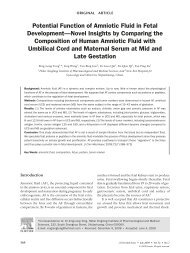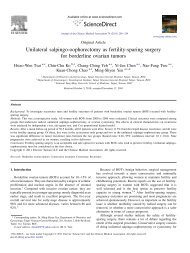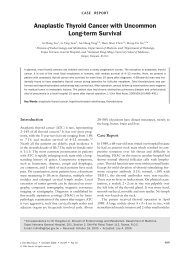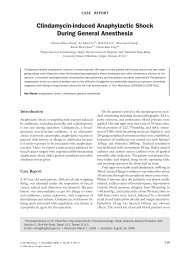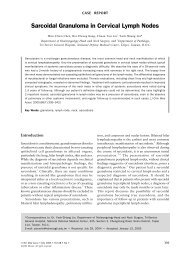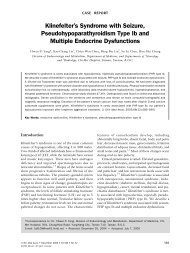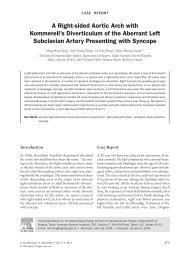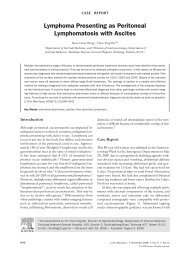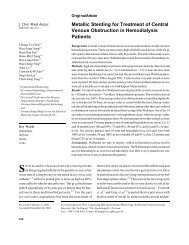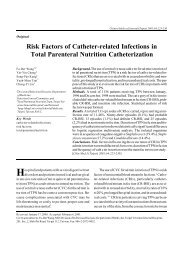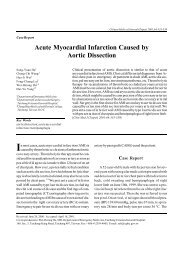Surgical Anatomy of Supratentorial Midline Lesions
Surgical Anatomy of Supratentorial Midline Lesions
Surgical Anatomy of Supratentorial Midline Lesions
You also want an ePaper? Increase the reach of your titles
YUMPU automatically turns print PDFs into web optimized ePapers that Google loves.
Arteries <strong>of</strong> the insula<br />
middle, and posterior short insular gyri, as well as the accessory<br />
and transverse gyri at its anteroinferior region.<br />
The gyri <strong>of</strong> the anterior insula fuse to form the insular<br />
apex, which is its most superficial area. The posterior insula<br />
consists <strong>of</strong> the anterior and posterior long insular gyri,<br />
which are separated by the postcentral insular sulcus. The<br />
insula constitutes the cortical covering that lies over the<br />
claustrum and putamen <strong>of</strong> the lentiform nucleus.<br />
Segments <strong>of</strong> the MCA<br />
The MCA is the most complex <strong>of</strong> all cerebral vessels<br />
(Fig. 1). This artery is divided into five major segments:<br />
M1 through M5. The M1 (sphenoidal) segment extends<br />
from the bifurcation <strong>of</strong> the ICA to the main MCA bifurcation,<br />
which is located adjacent to the limen insulae. The<br />
M2 (insular) segments extend from the main bifurcation to<br />
the periinsular sulci and the M3 (opercular) segments extend<br />
from the periinsular sulci to the lateral surface <strong>of</strong> the<br />
brain in the sylvian fissure. The M4 (parasylvian) segments<br />
are located on the parasylvian surface <strong>of</strong> the brain<br />
and the M5 (terminal) segments constitute distal extensions<br />
<strong>of</strong> the M4 segments. 5,7,9,16,18,19,21,22,25,34,35,38<br />
Materials and Methods<br />
The microsurgical anatomy <strong>of</strong> the arteries <strong>of</strong> the insula was studied<br />
in 20 formalin-fixed human cadaver brains (40 hemispheres).<br />
The ICA and vertebral arteries were dissected and cannulated at the<br />
neck, after which they were perfused with red latex to enhance their<br />
visibility. Following removal <strong>of</strong> the calvaria, the dura was opened<br />
carefully, the arachnoidea and pia were separated, and the sylvian<br />
fissure was opened. The origin, caliber, number, and course <strong>of</strong> the<br />
LLAs were studied with the aid <strong>of</strong> the operating microscope by using<br />
6 to 40 magnification. The cortical branches <strong>of</strong> the MCA<br />
could thus be demonstrated and their territories analyzed. Removal<br />
<strong>of</strong> the orbit<strong>of</strong>rontal, frontoparietal, and temporal opercula revealed<br />
the M1 to M5 segments <strong>of</strong> the MCA. Particular care was taken to preserve<br />
the pia that lay over the insular surface during removal <strong>of</strong> the<br />
opercula. The arteries <strong>of</strong> the insula were studied, placing particular<br />
emphasis on locating their origin and determining their number, diameter,<br />
and territory. In two specimens, coronal sections were explored<br />
to investigate the subcortical territory <strong>of</strong> the insular arteries.<br />
In three specimens, using the fiber-dissection technique, we defined<br />
the white matter pathways and dissected them in a stepwise fashion,<br />
promoting a precise study <strong>of</strong> the LLA territories in the putamen,<br />
globus pallidus, anterior commissure, and internal capsule.<br />
Results<br />
Sphenoidal (M1) Segment <strong>of</strong> the MCA<br />
In all specimens the ICA bifurcated into the MCA and<br />
ACA at the central portion <strong>of</strong> the anterior perforated substance.<br />
The M1 segment <strong>of</strong> the MCA coursed laterally and<br />
superiorly within the sylvian vallecula in the depths <strong>of</strong> the<br />
sylvian fissure and around the limen insulae to the insular<br />
apex, where it formed a genu. The average angle <strong>of</strong> the genu<br />
measured 97˚ (range 90–130˚). The average distance <strong>of</strong><br />
the genu from the limen insulae measured 4.8 mm (range<br />
2–9 mm). The average diameter <strong>of</strong> M1 segment was 3.21<br />
mm (range 2.6–4 mm) and the average length was 23.4<br />
mm (range 15–38 mm). The course <strong>of</strong> the M1 segment<br />
within the sylvian vallecula was found to be anterosuperior,<br />
superior, or posterosuperior. The demarcation distinguishing<br />
the M1 from the M2 segment is the bifurcation <strong>of</strong><br />
J. Neurosurg. / Volume 92 / April, 2000<br />
the MCA, which is located at the genu <strong>of</strong> the MCA, adjacent<br />
to the limen insulae (Fig. 2). We designated this particular<br />
bifurcation <strong>of</strong> the MCA as the main bifurcation. In<br />
23 hemispheres (57.5%), the main bifurcation was located<br />
at the genu. In an additional 11 hemispheres (27.5%), the<br />
main bifurcation was located 4 to 10 mm distal to the genu<br />
and, in the remaining six hemispheres (15%), it was located<br />
5 to 8 mm proximal to the genu. In two (5%) <strong>of</strong> the 40<br />
hemispheres, the temporal branch <strong>of</strong> the M 1 segment was<br />
strong and in one other hemisphere (2.5%) the frontal<br />
branch was strong, distinctly resembling the main bifurcation<br />
<strong>of</strong> the MCA; thus it was named a “false bifurcation.”<br />
34,35 Variations <strong>of</strong> the M 1 segment and the main bifurcation<br />
site <strong>of</strong> the MCA are described in detail in previous<br />
publications by the senior author (M.G.Y.). 34,35<br />
The anatomical patterns followed by branches <strong>of</strong> the M 1<br />
segment were observed to vary. They can be divided into<br />
two groups according to their territory <strong>of</strong> supply, the cortical<br />
arteries, and the LLAs.<br />
Cortical Arteries. In 38 hemispheres (95%) the M 1 segment<br />
gave rise to one to three major cortical branches,<br />
which were mainly located on the lateral aspect <strong>of</strong> M 1 segment<br />
(75.8%), supplying the temporal lobe, or on the medial<br />
aspect <strong>of</strong> the segment (24.2%), supplying the frontal<br />
lobe. In seven hemispheres (17.5%), we found one and,<br />
occasionally, two small arteries (uncal arteries) 0.3 to 0.5<br />
mm in diameter, supplying the piriform cortex. We did not<br />
designate this as a major cortical artery. The variations<br />
followed by the major cortical branches <strong>of</strong> the M 1 segment<br />
were classified into four types (Fig. 3). In Type A the<br />
M 1 segment gives rise to a temporal (lateral) branch. This<br />
was observed in 23 hemispheres (57.5%); in 17 hemispheres<br />
(42.5%), there was one temporal branch; in five<br />
hemispheres (12.5%), there were two temporal branches;<br />
and in one hemisphere (2.5%) there were three temporal<br />
branches. In Type B the M 1 segment gives rise to temporal<br />
(lateral) and frontal (medial) branches. This was observed<br />
in 14 hemispheres (35%); in 11 hemispheres (27.5%),<br />
there was one temporal and one frontal branch and, in<br />
three hemispheres (7.5%), there were two temporal and<br />
one frontal branch. In Type C the M 1 segment gives rise to<br />
a frontal branch only and no temporal branch. This was<br />
observed in one hemisphere (2.5%). In Type D the M 1 segment<br />
gives rise to no major cortical branches apart from<br />
the LLAs and uncal arteries. This was observed in two<br />
hemispheres (5%).<br />
Lateral Lenticulostriate Arteries. In all hemispheres the<br />
M 1 segment gave rise to the LLAs, located mainly on the<br />
inferomedial aspect <strong>of</strong> the M 1 segment within the sylvian<br />
vallecula. These arteries penetrated to the central and lateral<br />
portions <strong>of</strong> the anterior perforated substance, playing<br />
an important role in the blood supply <strong>of</strong> the substantia innominata,<br />
putamen, globus pallidus, head and body <strong>of</strong> the<br />
caudate nucleus, internal capsule and adjacent corona radiata,<br />
and the lateral portion <strong>of</strong> the anterior commissure.<br />
The LLAs numbered between one and 15 (average 7.75)<br />
per hemisphere, and no clear correlation appeared to exist<br />
between the length <strong>of</strong> the M 1 segment and the number <strong>of</strong><br />
LLAs. The diameters <strong>of</strong> the LLAs at their origin ranged<br />
between 0.1 and 1.5 mm (average 0.45 mm). The majority<br />
(73%) <strong>of</strong> LLAs measured less than 0.5 mm in diameter.<br />
The remainder (27%) were larger in diameter and most<br />
677



